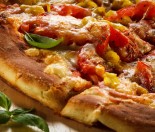Children and snacking is something that many parents worry about. Are my children snacking too much? Is it ok to snack between meals? What sort of food should I be giving as snacks? These are all common concerns but they don’t have to be. Snacking is a normal part of most children’s diet and can provide valuable energy and nutrition.
Children need a lot of energy from food throughout the day because of their high activity levels and growth rates. It can be difficult to get enough food in with just three meals a day as children get full very quickly. It’s a good thing to know too, that young children, up to about age three or four, have a good sense of when they are full. Unfortunately, as they get older they slowly lose this ability. We as parents can help them to keep this awareness by respecting their opinions of when they are full or not. This can seem a little frustrating as some days children will eat everything on their plate and ask for more and other days they will hardly eat a thing. Just like us however, it is natural for them to have hungry and non-hungry days. Allowing your child to listen to their hunger and fullness signals is a great skill to nurture.
Some children like to snack more than others. This could be for a number of reasons including that they simply like the snack choices better than the meal choices. Other reasons can be that it is habit because there is always food on offer or they simply prefer to eat small amounts often. Whatever the reasons it is important to make snacks nutritious. Allowing your child to eat an endless supply of biscuits and crackers between meals and then expecting them to still eat a plate of vegetables at dinner may not work out so well. Instead try for a balance.
I recommend making snacks almost like another meal. When my children are at home I offer morning and afternoon tea on a plate and they sit at a table. It may not always be at the kitchen table but I do expect them to sit (some days are more successful than others). On the plate I offer a small selection of food. Fruit is always included and then there will be an assortment of choices such as yoghurt, nuts, biscuits or cake, crackers and cheese, vegetable sticks, hummus, popcorn, a sandwich, milk or hot chocolate. Sometimes they’ll request cereal and milk. This isn’t all offered at one snack – usually two or three different things each time. I usually try and gauge how much to offer by how much or little was eaten at the last meal and how hungry they say they are. I also allow them to ask for more if they’ve finished the first selection. When they are full then this is usually it until the next meal. By treating snacks as another meal this helps to avoid grazing right up until lunch or dinner and then your child not eating the meal you have prepared. The extra benefit of serving snacks all at once is that if you have young children you aren’t forever tripping to the kitchen to find yet another food that will satisfy the war cry of “I’m hungry”.
There is also the trap of offering too much food and overwhelming your child. If your child is someone who doesn’t eat much it can be tempting to offer a big range of foods in the hope that one of them will be appealing and they will at least eat something. Unfortunately, this can have the opposite effect as too much food seems overwhelming and can discourage children from eating. In this case offer a small selection of foods and perhaps increase the number of times you offer it. Or perhaps your expectation of how much they should be eating doesn’t quite fit with how much they actually need or want.
The way snacks are prepared can influence how successfully they are eaten. A child is much more likely to eat an apple if it has been cut into quarters first. Vegetables sticks dipped in hummus can seem way more appealing than a big carrot taken straight out of the fridge. Cut sandwiches in halves or quarters. My pre-schooler likes to have nuts served in a little container rather than on her plate so I do this as it means she will eat the lot. There are many suggestions out there for making smiley faces with food or arranging the food on a plate to look like a picture. These can be great if you like to do this and have the time but to be honest I have never wanted to get into that habit. Quick and simple is really important for me. Quickly chopping up some fruit and making a simple peanut butter sandwich has always seemed a lot easier.
I offer all the food at the same time so that some foods don’t get a higher status than others. When foods have a higher status they become “better” than other foods and the preferred option. This can apply to biscuits, chips, lollies etc. I serve biscuits at the same time as the fruit and often the fruit is eaten first. Other foods like chips and lollies will get eaten first but I only offer a small amount occasionally and then the rest of the food is eaten as well.
An important point to keep in mind is that some of the fruit available is huge and way too much for a small child to eat all at once – their cupped hand is a good indication of how big a portion is for each particular child. As their hand grows then their portion sizes increase along with their growth. This is just a guide and your child might like to eat more or less. Throughout the day if they get 5 serves of fruit and vegetables, in any combination, then you can give yourselves a pat on the back. Five serves is five of their cupped hands full of fruit and/or vegetables. Vegetables seem to be the hardest for many parents to get their children to eat and if your child is against anything vegetable then offering them more fruit is a good alternative.
Snacks can be an important part of a child’s nutrition it doesn’t mean that they have to have snacks. If your child is someone who prefers to eat three meals a day without much in between then this is perfectly ok too. The important thing to remember is that if your child does like to snack the snacks served should be providing some of their nutrition for the day. Snacking shouldn’t only consist of chips, biscuits and cake but as long as there are some other choices such as fruit, nuts, yoghurt etc then there is no reason why these can’t be offered in small quantities as well.
Below are some different snack suggestions. Not all will be to your child’s liking or fit within your lifestyle but it will get you started in the direction of increasing variety and help you to think of new ideas if stuck. I’d love to hear what your child’s favourite snack is so please let us know in the comments below.
Snacks for children
- Crackers with cheese, marmite, honey, cottage cheese, hummus, pate …
- Olives, pickles, gherkins, pickled onions
- Salami, bier sticks, biltong (dried meats)
- Nuts and seeds (try dry frying with some coriander, cumin, paprika and salt. Yum!)
- Popcorn, pretzels
- Toasted pita wedges
- Vegetables, snow peas, baby corn, mushrooms, carrot sticks, capsicum, tomato wedges, cucumber chunks
- Celery and peanut butter
- Fruit pieces or tinned fruit
- Sushi
- Small piece of cake, loaf or biscuit
- Yoghurt
- Custard
- Hummus or dip
- Hard-boiled egg
- Cheese sticks or cubes
- Sandwich







My toddler likes soup, dried fruit, tofu bits, and vegetarian sausage bits.